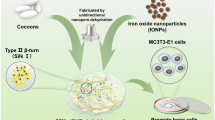Abstract
Photocurable biocompatible hydrogels were fabricated from methacrylated gelatin and silk proteins (a recombinant analogue of spidroin from Nephila clavipes spider web and fibroin from the cocoons of the silkworm Bombyx mori). These polymers are widely applicable in tissue engineering due to their biocompatibility and biodegradability. Hydrogels were fabricated using two different methods that allowed to obtain either the macroscopic scaffolds or microstructures with a defined shape. Three-dimensional hydrogel samples were prepared via monomers solution photopolymerization for 10 min. As a result, the disk-shaped samples of hydrogels approximately 13 mm in diameter were fabricated. Their porous structure was confirmed by scanning electron microscopy. Microstructures were formed on coverslips using an Eclipse Ti-E microscope equipped with an A1 confocal module (Nikon, Japan) and 405 nm laser. This approach allows to control the topographic features of the obtained substrates, and it is viable for creating the micropattern surfaces to reveal for studying the interaction of cells with a substrate.
Similar content being viewed by others
References
Li, S., Tuft, B.W., Xu, L., Polacco, M.A., Clarke, J.C., Guymon, C.A., and Hansen, M.R., Microtopographical features generated by photopolymerization recruit RhoA/ROCK through TRPV1 to direct cell and neurite growth, Biomaterials, 2015, vol. 53, pp. 95–106.
Chia, H.N. and Wu, B.M., Recent advances in 3D printing of biomaterials, J. Biol. Eng., 2015, vol. 9, p.4.
Yue, K., Trujillo-de Santiago, G., Alvarez, M., Tamayol, A., Annabi, N., and Khademhosseini, A., Synthesis, properties, and biomedical applications of gelatin methacryloyl (GelMA) hydrogels, Biomaterials, 2015, vol. 73, pp. 254–271.
Xiao, W., He, J., Nichol, J.W., Wang, L., Hutson, C.B., Wang, B., Du, Y., Fan, H., and Khademhosseini, A., Synthesis and characterization of photocrosslinkable gelatin and silk fibroin interpenetrating polymer network hydrogels, Acta Biomater., 2011, vol. 7, no. 6, pp. 2384–2393.
Moisenovich, M.M., Pustovalova, O.I., Shackelford, J., Vasiljeva, T.V., Druzhinina, T.V., Kamenchuk, Y.A., Guzeev, V.V., Sokolova, O.S., Bogush, V.G., Debabov, V.G., Kirpichnikov, M.P., and Agapov, I.I., Tissue regeneration in vivo within recombinant spidroin 1 scaffolds, Biomaterials, 2012, vol. 33, no. 15, pp. 3887–3898.
Sidoruk, K.V., Davydova, L.I., Kozlov, D.G., Gubaidullin, D.G., Glazunov, A.V., Bogush, V.G., and Debabov, V.G., Fermentation optimization of a Saccharomyces cerevisiae strain producing 1F9 recombinant spidroin, Appl. Biochem. Microbiol., 2015, vol. 51, no. 7, pp. 766–773.
Caló, E. and Khutoryanskiy, V.V., Biomedical applications of hydrogels: A review of patents and commercial products, Eur. Polym. J., 2015, vol. 65, pp. 252–267.
Kamoun, E.A., Kenawy, E.R.S., and Chen, X., A review on polymeric hydrogel membranes for wound dressing applications: PVA-based hydrogel dressings, J. Adv. Res., 2017, vol. 8, no. 3, pp. 217–233.
Arkhipova, A.Y., Nosenko, M.A., Malyuchenko, N.V., Zvartsev, R.V., Moisenovich, A.M., Zhdanova, A.S., Vasil’eva, T.V., Gorshkova, E.A., Agapov, I.I., Drutskaya, M.S., Nedospasov, S.A., and Moisenovich, M.M., Effects of fibroin microcarriers on inflammation and regeneration of deep skin wounds in mice, Biochemistry (Moscow), 2016, vol. 81, no. 11, pp. 1251–1260.
Moisenovich, M.M., Malyuchenko, N.V., Arkhipova, A.Y., Kotlyarova, M.S., Davydova, L.I., Goncharenko, A.V., Agapova, O.I., Drutskaya, M.S., Bogush, V.G., Agapov, I.I., Debabov, V.G., and Kirpichnikov, M.P., Novel 3D-microcarriers from recombinant spidroin for regenerative medicine, Dokl. Biochem. Biophys., 2015, vol. 463, no. 1, pp. 232–235.
Burri, O., Wolf, B., Seitz, A., and Gönczy, P., TRACMIT: An effective pipeline for tracking and analyzing cells on micropatterns through mitosis, PLoS ONE, 2017, vol. 12, no. 7, p. e0179752.
Author information
Authors and Affiliations
Corresponding author
Additional information
Original Russian Text © I.V. Bessonov, M.S. Kotliarova, M.N. Kopitsyna, A.V. Fedulov, A.M. Moysenovich, A.Yu. Arkhipova, V.G. Bogush, D.V. Bagrov, A.A. Ramonova, A.E. Mashkov, K.V. Shaitan, M.M. Moisenovich, 2018, published in Vestnik Moskovskogo Universiteta, Seriya 16: Biologiya, 2018, Vol. 73, No. 1, pp. 29–33.
About this article
Cite this article
Bessonov, I.V., Kotliarova, M.S., Kopitsyna, M.N. et al. Photocurable Hydrogels Containing Spidroin or Fibroin. Moscow Univ. Biol.Sci. Bull. 73, 24–27 (2018). https://doi.org/10.3103/S0096392518010030
Received:
Published:
Issue Date:
DOI: https://doi.org/10.3103/S0096392518010030




